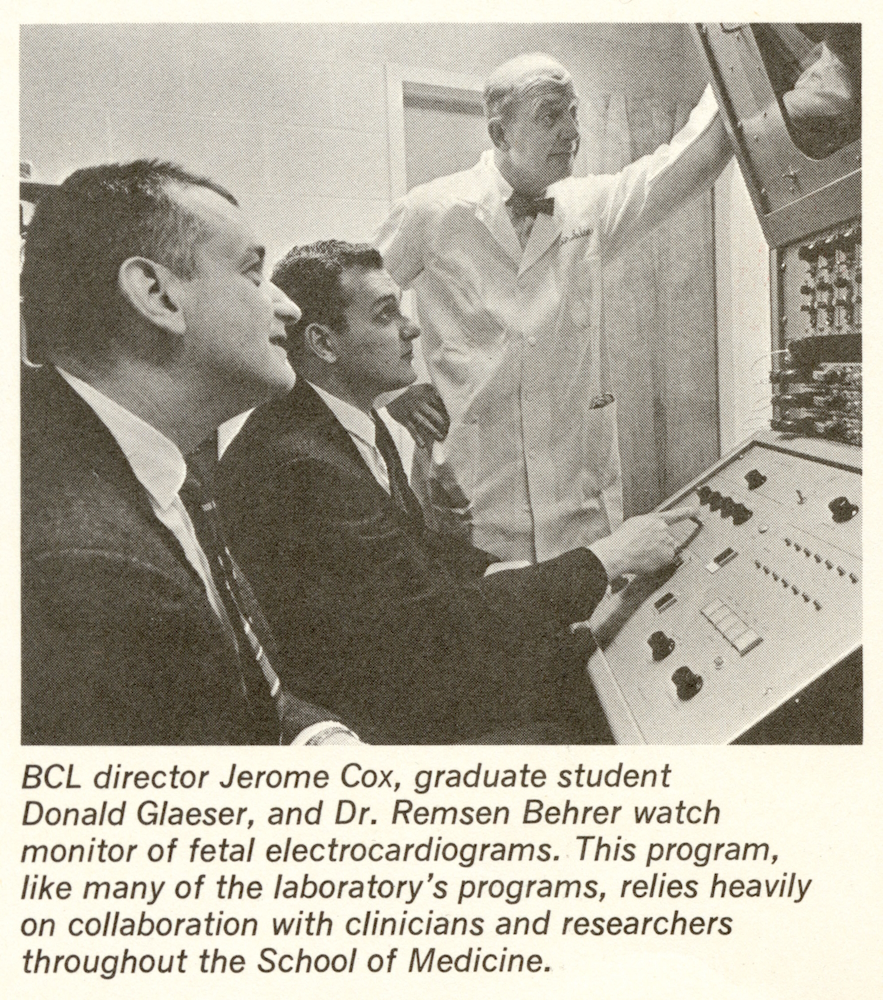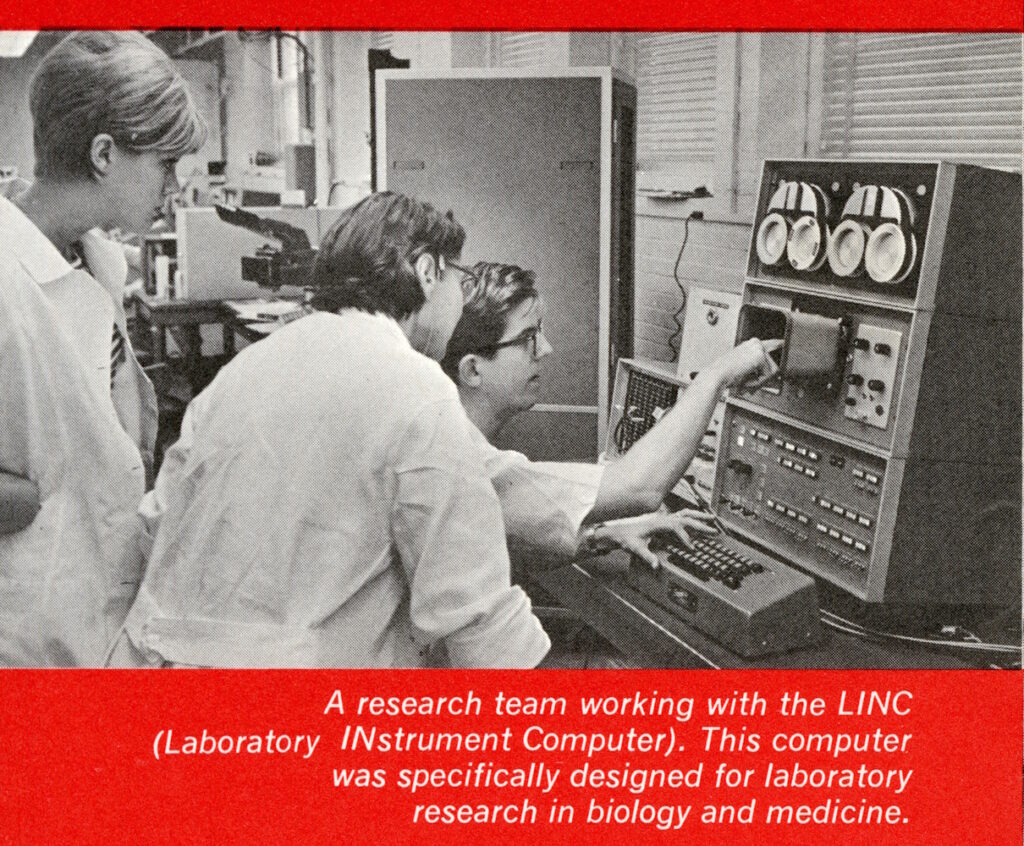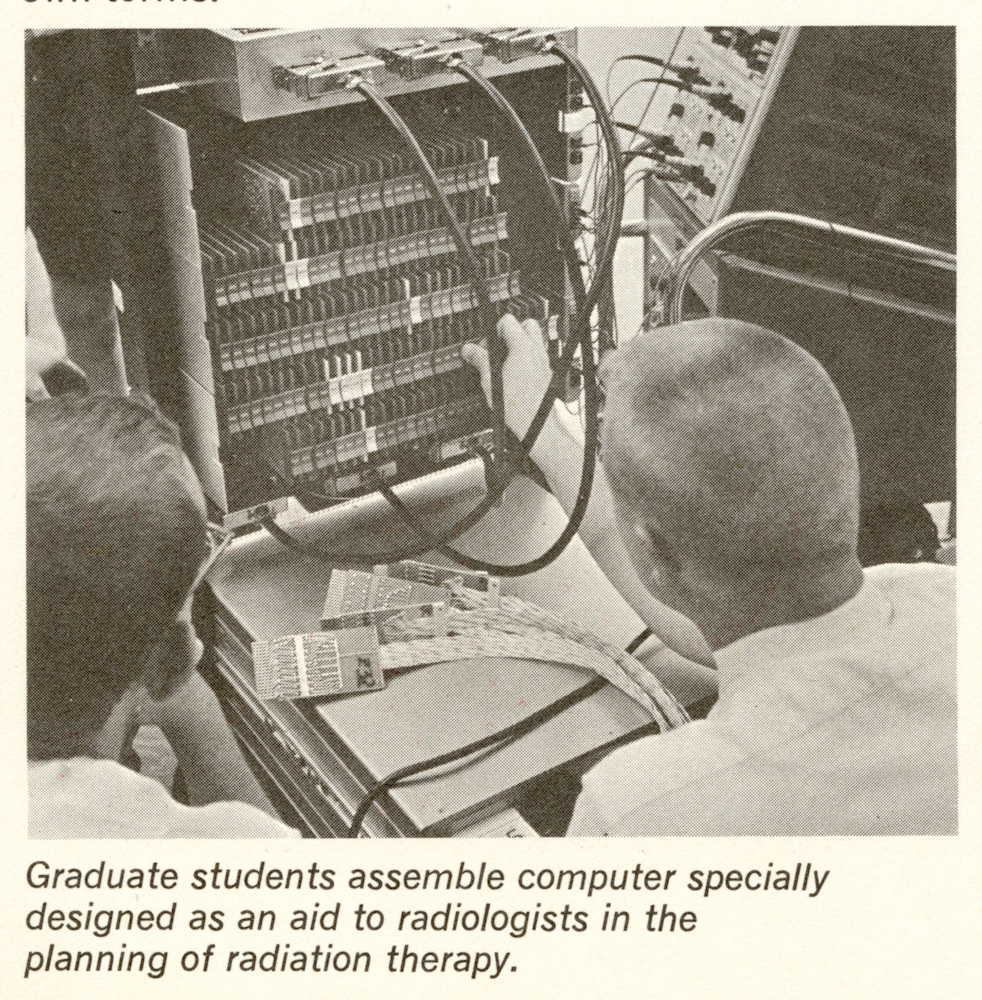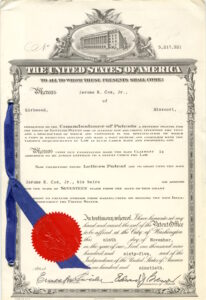
Did you know the PC was invented at Washington University?
Well, not that PC. The Programmed Console.
In the spring of 1965, Jerome R. Cox Jr. and Wesley A. Clark co-taught a graduate course in computer design in which teams of students designed working computers. One student, V.W. “Bill” Gerth, also wrote an interactive radiation treatment planning program. A demonstration piqued the interest of the Division of Research Resources at the National Institutes of Health (NIH), which subsequently directed funding to the Biomedical Computer Laboratory (BCL), a division of the School of Medicine, to further develop the concept.
Cox—who had founded BCL the previous spring—and colleagues in the Mallinckrodt Institute of Radiology went to work. He called the redesigned computer the Programmed Console, or PC, reflecting the unique way that users could interact directly with stored programs at a display console. Software was designed to enable radiologists to calculate the optimal position and intensity of radiation beams to treat a tumor, while minimizing damage to surrounding, healthy tissue. And with NIH support, BCL initiated a Radiation Treatment Planning (RTP) Project that supplied PCs to teams from six different institutions to evaluate and refine their use in radiation therapy over the course of several years.
Documents about the PC are among the many materials found in the recently processed papers of Dr. Jerome “Jerry” R. Cox Jr. (1925-2023). Acquired by the Becker Archives in 2022, this rich collection provides a window into Cox’s nearly five-decade career at Washington University, documenting his path-breaking work in biomedical computing and computer science and revealing a dedicated researcher, teacher, and advocate whose influence and impact extended far beyond the classroom.
Video about acquiring the Jerome Cox Papers, created by Becker Library.
Images excerpted from a BCL brochure explaining the research and training activities available to graduate students, circa 1965 (FC157-S13-ss01-B077-F05, Bernard Becker Medical Library Archives, Washington University in St. Louis).
A significant portion of the collection pertains to Cox’s tenure as director of BCL (1964-1975), when he played a pivotal role in Washington University’s journey toward becoming a leader in the application of computers to biomedicine. Cox had first joined the university’s faculty as a part-time assistant professor of electrical engineering in 1955, after accepting a position at the nearby Central Institute for the Deaf (CID). He moved on from CID to found BCL in April 1964. That same year, the LINC development team at MIT found itself in need a new institutional home, and Cox was instrumental in making sure they had one at Washington University. The LINC, or Laboratory INstrument Computer, was a small-for-its-time, mobile, and interactive computer designed with lab-based research in mind. The LINC team relocated to St. Louis in June 1964 and continued their work in the newly formed Computer Research Laboratory (CRL), which shared space with BCL on the Medical Campus. In 1967, with funding from a major NIH grant titled “A Resource for Biomedical Computing,” the Washington University Computer Laboratories (WUCL) formed around BCL and CRL’s successor, the Computer Systems Laboratory (CSL). Cox chaired WUCL until the completion of the grant in 1983. “Few laboratories in the nation,” a summary report noted, “have had as deep an impact on the evolution of computers in medicine and medical research as CSL and BCL.”

Another substantial portion of the collection documents Cox’s roles as the first chair of the Department of Computer Science (1975-1991) and as director of the Applied Research Laboratory (1991-1995). Much like his contributions to biomedical computing, Cox’s work on computer networking and the high-speed transmission of medical images during this time helped Washington University become a leader in those fields. It also prompted Cox to co-found Growth Networks Inc. in 1997, an effort to commercialize university-developed fast-packet chipset technology. Cisco Systems later acquired the successful company in 2000. Cox’s business ventures continued in 2007, when he founded Blendics, derived from Blended Integrated Circuit Systems. Blendics led to a cybersecurity spin-off, Q-Net Security Inc., in 2015. The collection contains a moderate amount of materials related to Cox’s entrepreneurial endeavors.
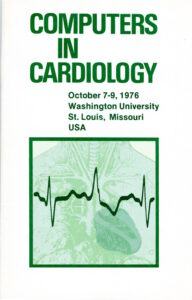
Cox’s writings and professional activities are also well-represented. In addition to manuscripts and drafts, the collection contains reprints of many of his published journal articles. Prominent among Cox’s professional activities was his role as co-founder and co-chair of Computers in Cardiology. The annual international conference brought together researchers applying computers to electrocardiography. Organizers also made sure attendees had a chance to explore the host cities. When Washington University hosted the gathering in 1976, the social calendar included a visit to the Missouri Botanical Gardens, a riverboat cruise, and a rooftop reception at the Chase Park Plaza Hotel. Cox served as co-chair until 1988, and the conference, now known as Computing in Cardiology, continues to be held today.
The Cox papers are open and accessible for research. In addition to the materials mentioned here, researchers can find administrative documents, correspondence, grant applications, research notes, patents, photographs, and more pertaining to his extensive work in auditory physiology, ECG analysis and processing, CT and PET scanning technologies, DNA mapping, information systems and database technologies, electronic radiology, digital communication networks, and asynchronous computing. The collection also contains a modest number of materials related to Cox’s personal life.
Certificate for U.S. Patent No. 3,217,321, Collision Avoidance System, November 9, 1965 (FC157-S06-B017-F10, Bernard Becker Medical Library Archives, Washington University in St. Louis). Cox’s work also led to patents related to tomography systems, video with high speed reconstruction and display of compressed images, and asynchronous computing.

